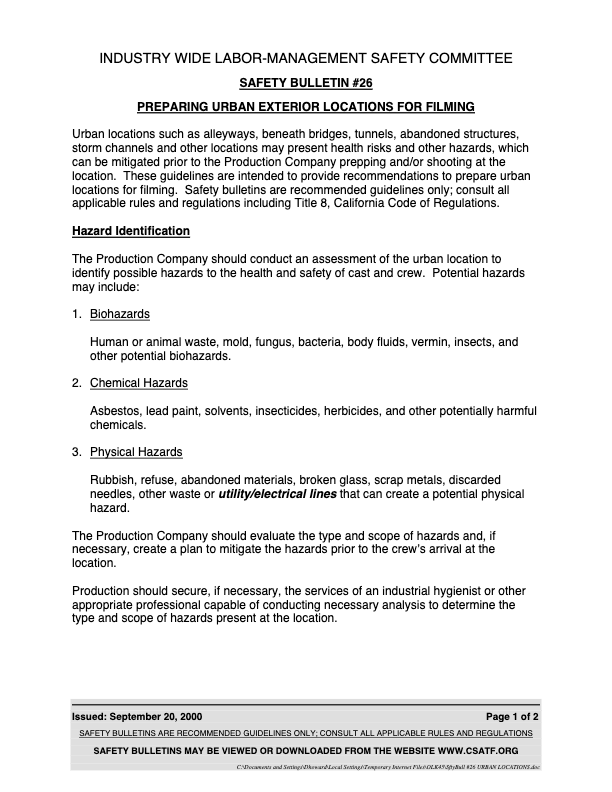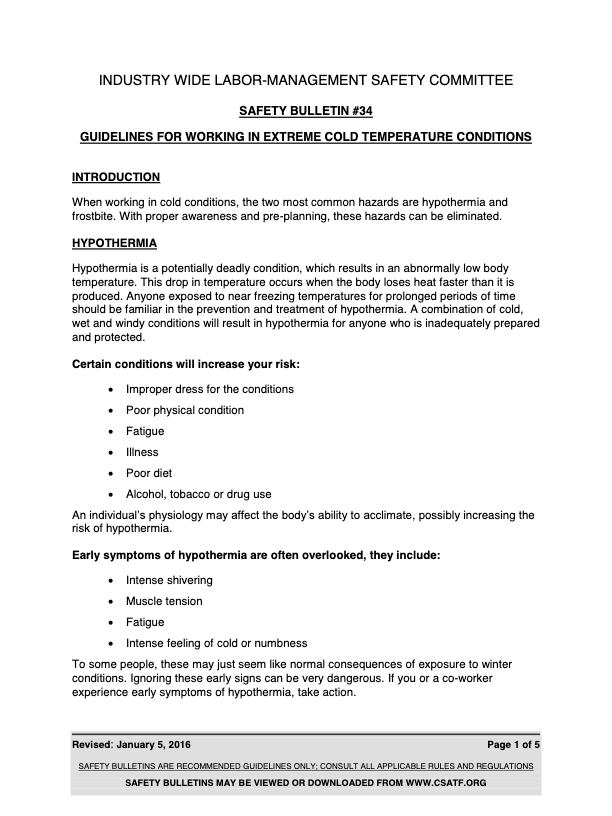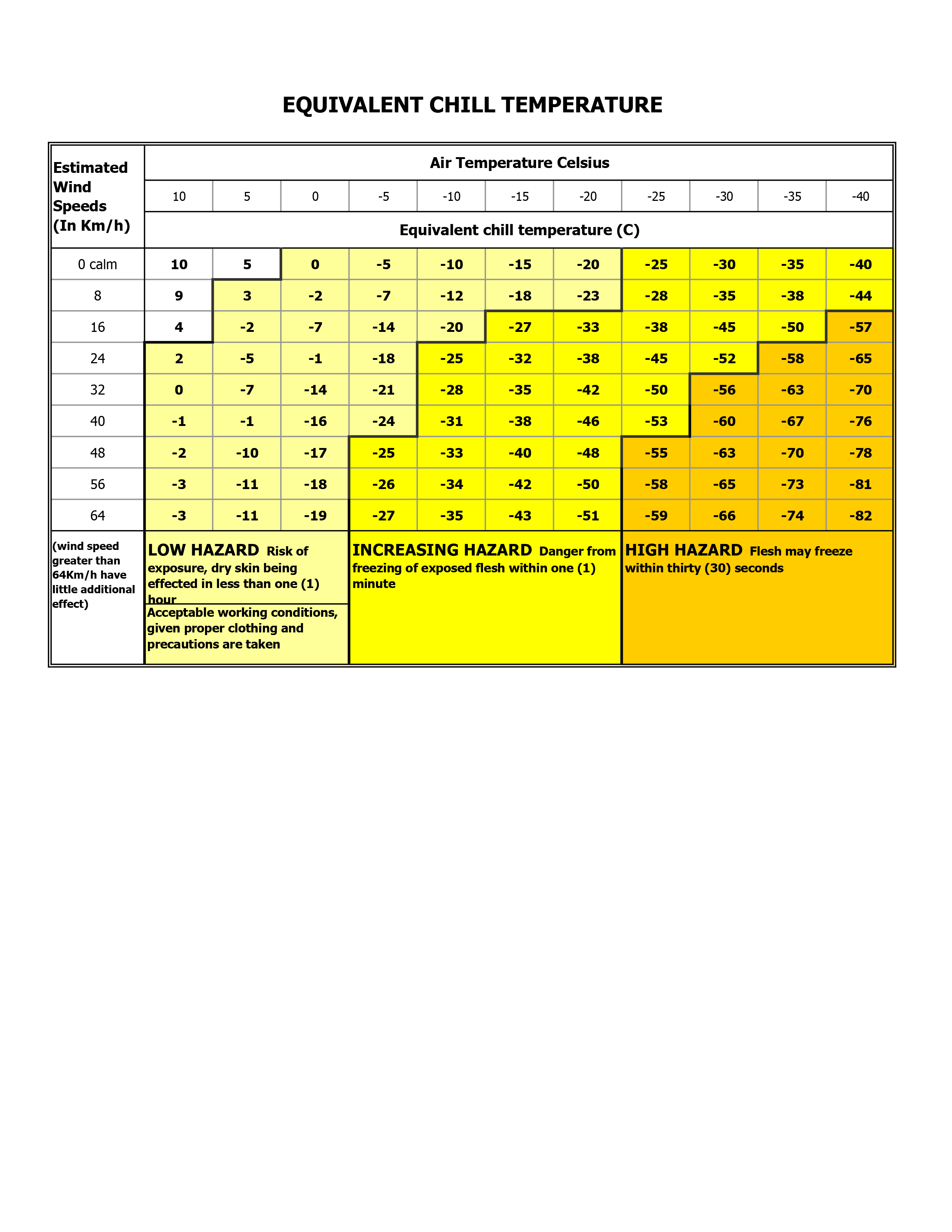Urban locations
Urban locations such as alleyways, beneath bridges, tunnels, abandoned structures, and storm channels may present health risks and other hazards. Potential hazards may include:
- BIOHAZARDS: Human or animal waste, mold, fungus, bacteria, body fluids, vermin, insects, and other potential biohazards.
- CHEMICAL HAZARDS: Asbestos, lead paint, solvents, insecticides, herbicides, and other potentially harmful chemicals.
- PHYSICAL HAZARDS: Rubbish, refuse, abandoned materials, broken glass, scrap metals, discarded needles, other waste or utility/electrical lines that can create a potential physical hazard.
The Producer should evaluate the type and scope of hazards and, if necessary, consult with appropriate professionals to create a plan to mitigate the hazards prior to the crew’s arrival at the location. This plan should be presented at the Director’s Prep.
If possible, the urban location should be locked-off and secured to maintain the cleanliness of the set. If that is not practical, Production should conduct daily cleaning activities before crew call to remove any sources of exposure or hazards that accumulated during the Production Company’s absence.
Electrical cables, props, and other equipment used at the location should be protected where practical. Cables should be supported off the ground whenever possible. Protective ground cover, such as layout board or other material, should be positioned in work areas to minimize contact with potentially affected areas. Props and equipment that come in contact with the ground should be disinfected. Washing facilities should be available for the cast and crew, who should be reminded to wash periodically and before meals. Long pants, long sleeved shirts, and hard-soled shoes are recommended to minimize contact. Proper personal protective equipment should be provided and used.
Rural locations
Rural locations such as fields, wooded areas, swamplands, rivers, and farms may present health risks and other hazards. Potential hazards may include:
- CRITTERS: Ants, ticks, insects, spiders, snakes, alligators, marine animals, vermin, bears, bobcats, and other potentially dangerous wildlife.
- BIOHAZARDS: Human or animal waste, mold, fungus, bacteria, body fluids, and other potential biohazards.
- PHYSICAL HAZARDS: Poisonous plants, refuse, abandoned materials, water, sharp objects, and other potential physical hazards.
Consider safety precautions when pre-planning and preparing to use a rural location that may contain indigenous critters or environmental hazards. This should include: identifying the type(s) of critters or hazards present; the location of nearby hospitals or medical facilities; and the availability of any anti-venom that may be required. Identify the areas that may contain the plants and use the proper safeguards to avoid them. Pre-planning may also include contacting the local zoo to see if they have the anti-venom and to alert them you will be working in the area, especially if the production will be working with animal actors that could escape.
It is production’s responsibility to assure the safety of the indigenous critters in the filming area, and to consult the agency or persons responsible for the removal of wildlife from location sets. Any such indigenous critters that remain on the set are subject to American Humane Association Guidelines and Procedures.
Wear long pants with the pant legs tucked into socks or boots. A good boot above the ankle will provide better protection. It is also advisable to wear a long-sleeved shirt, dress in layers and wear light colors. (Generally, critters are dark in color; they are spotted easily against a light background.) Avoid heavy perfumes or after-shaves as they attract some pests. Apply repellents according to label instructions on the product. Applying repellents to clothing appears to be most effective.
Wear practical change clothes and shoes before leaving the location. Work clothes should be placed in a bag and taken home for laundering.
Wash often. Wash hands before eating, smoking or applying cosmetics.
In the case of bites or stings, serious allergic reactions are possible. If you have any known allergies, notify the set medic and/or safety representative prior to or when you first arrive at the location. If you are bitten or stung by an indigenous critter, immediately contact the set medic. If the encounter with the indigenous critter involves a life threatening situation, call 911.









